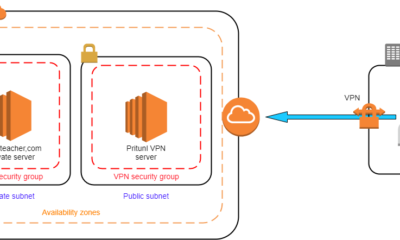DevOps
Understanding the Difference Between /Usr/Bin /Usr/Local/Bin And /Bin: A Guide
Are you new to the world of Linux and feeling overwhelmed by the complex directory structure? If you’ve ever encountered paths like /usr/bin, /usr/local/bin, and /bin, you’re not alone in wondering what they mean.
Understanding these directories is crucial for navigating and utilizing your Linux system efficiently. They may seem like just a few more folders at first glance, but each serves a distinct purpose that can impact how your software runs and how you manage your system.
We’ll break down these directories in simple terms, helping you grasp their roles and differences without getting lost in technical jargon. By the end, you’ll not only know where your applications are stored but also gain confidence in managing your Linux environment like a pro. Dive in, and let’s clear up the confusion together!

Credit: github.com
/bin Directory
The /bin directory contains essential system programs needed for booting and repairing. /usr/bin hosts user-installed software and system applications, while /usr/local/bin stores locally compiled or custom programs, ensuring separation from system-managed packages. Understanding these differences helps in managing Linux directories efficiently.
Understanding the various directories in a Linux system can feel like unraveling a mystery. But once you get the hang of it, you’ll find it rewarding. One such directory is the /bin Directory. It’s the home for essential commands that make your system tick. You might wonder why it’s so crucial. Let’s dive into its significance and what sets it apart from other directories.System Executables
The /bin Directory is like a toolbox for your system. It contains executable programs that are necessary for booting up and running your system smoothly. These executables are universally accessible by all users, making them integral to system operations. Think of it as the backbone of your operating system. Without these executables, your system wouldn’t know how to perform basic tasks. You can imagine the chaos if these were missing—no booting, no terminal commands, just a silent screen.Essential Commands
The commands stored in the /bin Directory are not just any commands; they are essential for system functionality. We’re talking about commands like `ls`, `cp`, `mv`, and `rm`. These commands are fundamental for navigating and managing your files. Have you ever tried to move a file or list directory contents and wondered where those commands come from? They reside in the /bin Directory. Knowing their location can be handy when troubleshooting or learning more about your system’s inner workings. Next time you open your terminal, pause for a moment. The commands you type are drawn from this vital directory. Does knowing where they originate from change how you view the terminal? Understanding these commands’ roots can deepen your appreciation for how Linux systems operate.
Credit: www.geeksforgeeks.org
/usr/bin Directory
The /usr/bin directory holds essential user command binaries. Meanwhile, /usr/local/bin contains user-installed programs, separate from system files. On the other hand, /bin includes basic system command binaries available during booting. Understanding these directories helps manage system resources effectively.
The `/usr/bin` directory is a crucial part of Unix-like systems. It houses many essential user-level programs. These programs are available to all users. This directory is often shared across systems in a network. Understanding its purpose can enhance your system management skills.User-level Commands
The `/usr/bin` directory contains user-level commands. These commands are accessible by all users on the system. Think of it as a toolbox for everyday tasks. Programs here include common utilities and applications. They are vital for daily operations. Users can run these commands without needing root access.Shared Resources
The `/usr/bin` directory serves as a hub for shared resources. It allows multiple users to access the same applications. This setup ensures consistency across different user sessions. It reduces redundancy and saves storage space. Administrators can manage updates efficiently. This centralized structure supports smoother system operations./usr/local/bin Directory
Different directories serve distinct purposes in Linux. ‘/usr/local/bin’ stores user-installed software, separate from system-wide applications in ‘/bin’ and ‘/usr/bin’. This separation allows for customization without affecting core system files. Understanding these directories helps manage software installations effectively.
When navigating the complex world of Unix-like operating systems, understanding the purpose of various directories is crucial. The `/usr/local/bin` directory, in particular, holds significant importance for both beginners and seasoned users. This directory is a special space where you can store and manage software that you compile or install manually. It ensures that your custom installations do not interfere with the system-wide software managed by the package manager.Custom Installations
The `/usr/local/bin` directory is a safe haven for your custom software installations. Imagine downloading a new tool that isn’t available through your system’s package manager. You can install it directly into `/usr/local/bin`, keeping it separate from the system’s standard binaries. This way, even if system updates occur, your custom programs remain untouched. This setup also allows you to easily manage and track your manually installed software. Whenever you wish to remove or update these applications, you know exactly where to look.Locally Compiled Programs
Have you ever compiled a program from source code? The `/usr/local/bin` directory is the perfect place for the resulting binaries. When you compile software locally, you often have specific needs or preferences not met by pre-packaged binaries. By placing the compiled programs in `/usr/local/bin`, you maintain an organized system, distinct from the system’s native applications. This distinction provides a clear boundary, ensuring that your custom tweaks or experimental features don’t clash with standard system operations. Moreover, having a dedicated directory for locally compiled programs makes it easier to share and back up your custom tools. You can easily migrate them to another system without affecting the core binaries.When you think about organizing and managing your software, where do you store your custom tools? The `/usr/local/bin` directory might just be the solution you need for a seamless, organized system.
Purpose And Usage
Learn the distinct roles of directories in Linux systems. The directory “/usr/bin” holds essential user commands, while “/usr/local/bin” contains user-installed software. The directory “/bin” stores crucial system commands needed for booting and system recovery. Each serves a unique purpose in your system’s functionality.
Understanding the purpose and usage of directories like `/usr/bin`, `/usr/local/bin`, and `/bin` is crucial for anyone who wants to navigate the Linux or Unix file systems with confidence. These directories may seem similar at first glance, but each has a distinct role that affects how software is organized and executed on your system. Recognizing their differences can streamline your system administration tasks and optimize your user experience.System Vs. User Directories
Directories such as `/bin` and `/usr/bin` are integral to your operating system. They house essential binaries needed for system booting and other critical operations. When you turn on your computer, these directories ensure everything runs smoothly from the get-go. On the other hand, `/usr/local/bin` is your playground. It’s where you can add your software without affecting the core system files. This separation ensures your custom installations don’t interfere with the system’s integrity. Have you ever had a time when a system update clashed with your custom software? Keeping them separated in `/usr/local/bin` can help avoid such headaches.Impact On System Administration
Efficient system administration hinges on understanding these directory distinctions. When performing system updates or backups, you can focus on `/bin` and `/usr/bin`, knowing that these are system-critical. This knowledge can save time and reduce errors. Using `/usr/local/bin` wisely can also make your system more secure. By placing user-specific software here, you limit the risk of accidental overwrites during system updates. Have you considered how often user modifications in system directories lead to errors? By isolating them in `/usr/local/bin`, you minimize such risks. Understanding these directories not only enhances your system management skills but also empowers you to troubleshoot and customize your environment effectively. What will you discover by exploring the depths of your own file system?Security Implications
Understanding the security implications of directories like /usr/bin, /usr/local/bin, and /bin is crucial. These directories play a key role in system security. Each directory has a specific purpose and access level. Mismanagement can lead to vulnerabilities. Knowing their differences helps in maintaining a secure system environment.
Access Control
Access control determines who can enter a directory. It controls who can execute files. The /bin directory is essential for basic system operations. It should have strict access control. Limiting access to /bin reduces the risk of unauthorized changes. The /usr/bin directory contains user commands. It has broader access but still requires control. The /usr/local/bin directory holds locally installed software. It often allows user access for custom installations. Proper management of access control protects these directories from threats.
File Permissions
File permissions define what actions users can perform. Permissions include read, write, and execute. In /bin, permissions should be strict to prevent unauthorized changes. Files in /usr/bin often have global read and execute permissions. This allows users to execute commands. /usr/local/bin files may have more flexible permissions. This flexibility supports local software management. Regular audits of file permissions ensure they align with security needs. Misconfigured permissions can lead to potential exploits.

Credit: dev.to
Best Practices
Understanding where binaries should reside is crucial for system organization. Properly managing these directories helps in maintaining system integrity and efficiency. Following best practices ensures a stable and predictable environment.
Organizing Binaries
Placing binaries in the correct directories is essential. Use /bin for essential system binaries. These are required for the system’s basic operation. For software distributed by the operating system, utilize /usr/bin. It serves as a repository for user-accessible programs. If you compile software manually, /usr/local/bin is the appropriate directory. This keeps custom software separate from system files.
Maintaining System Integrity
Maintaining system integrity involves careful management of binaries. Avoid mixing system and custom binaries. This prevents potential conflicts and ensures seamless updates. Regularly check /usr/local/bin for outdated or unused files. Remove or archive them to keep the directory clean. Regularly update system binaries to keep them secure. Follow the system’s package manager guidelines for updates. Ensure your custom binaries are compatible with new versions.
Frequently Asked Questions
What Is The Purpose Of /usr/bin?
/usr/bin contains binary executables for user programs. These are essential applications and utilities used by all system users. It is part of the user software hierarchy, providing access to general user commands and applications not critical to system boot.
How Does /usr/local/bin Differ From /usr/bin?
/usr/local/bin is for locally installed binaries. It hosts programs installed manually or by third-party packages, separate from standard system packages. This directory helps avoid overwriting during system updates, providing a space for custom software.
Why Is /bin Important For System Boot?
/bin contains essential binaries required for booting and system repair. It includes critical commands like ‘bash’ and ‘ls’. Unlike /usr/bin, it’s vital for initial system operations, ensuring the system can start and function properly even without other directories.
Can /usr/bin And /bin Have Similar Files?
Yes, they may contain similar executables. Some utilities are present in both for redundancy. /bin ensures availability during boot, while /usr/bin provides extended functionality once the system is fully operational.
Conclusion
Grasping the differences between /usr/bin, /usr/local/bin, and /bin matters. Each directory serves a unique purpose in Linux systems. Understanding their roles enhances system management skills. /bin holds essential binaries. /usr/bin has standard system commands. /usr/local/bin stores custom scripts and programs.
Knowing where binaries reside helps in troubleshooting. It ensures proper program execution. This knowledge supports effective file organization and management. Exploring these directories improves your Linux journey. You gain confidence in handling file paths. Keep learning to master file systems.
Your Linux experience becomes smoother and more efficient.
-

 DevOps6 years ago
DevOps6 years agoSaltstack Tutorial for beginners [2025]
-

 DevOps6 years ago
DevOps6 years agoHow to build a Docker cron job Container easily [2025]
-

 Linux7 years ago
Linux7 years agomail Command in Linux/Unix with 10+ Examples [2025]
-

 DevOps6 years ago
DevOps6 years agoDocker ADD vs COPY vs VOLUME – [2025]
-

 DevOps6 years ago
DevOps6 years agoHow to setup Pritunl VPN on AWS to Access Servers
-

 Linux6 years ago
Linux6 years agoGrep Command In Unix/Linux with 25+ Examples [2025]
-

 Linux7 years ago
Linux7 years agoFind command in Unix/Linux with 30+ Examples [2025]
-
Linux5 years ago
How To setup Django with Postgres, Nginx, and Gunicorn on Ubuntu 20.04

